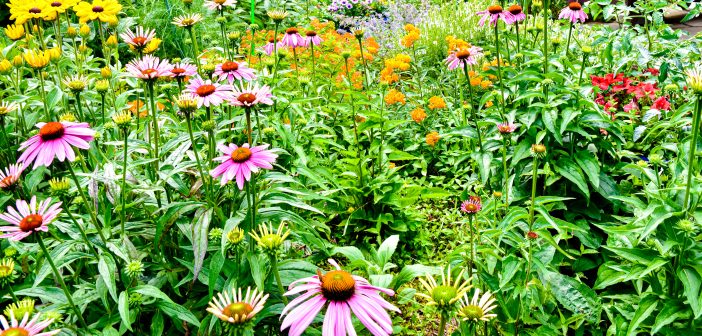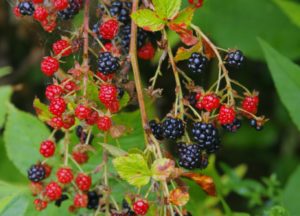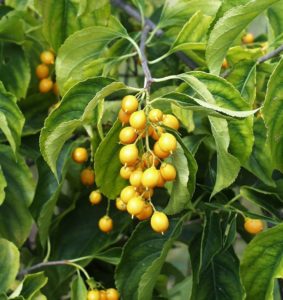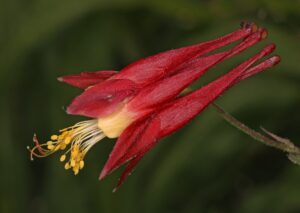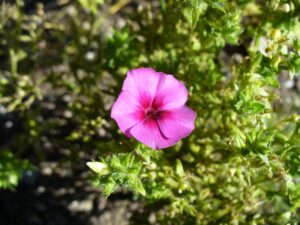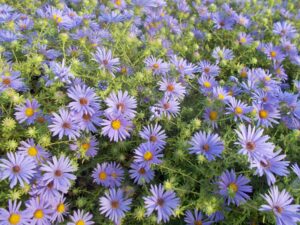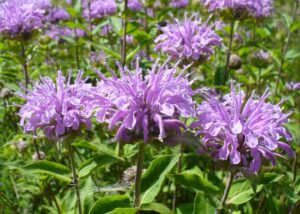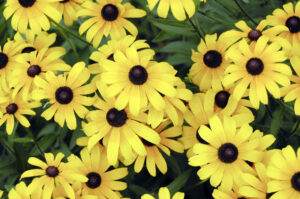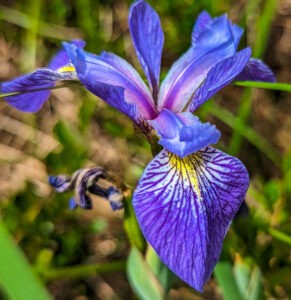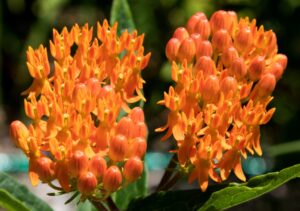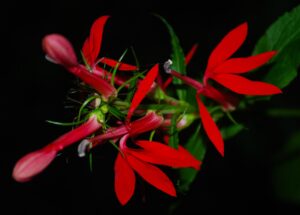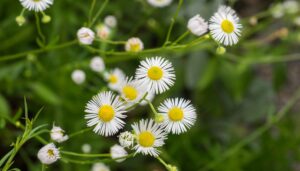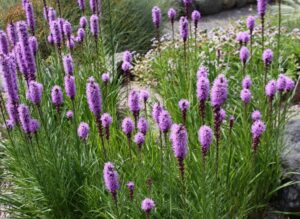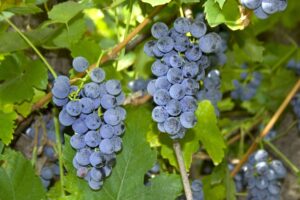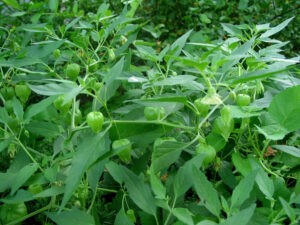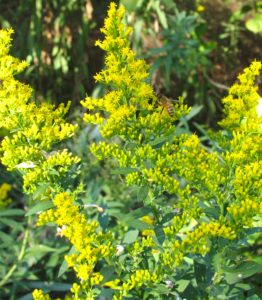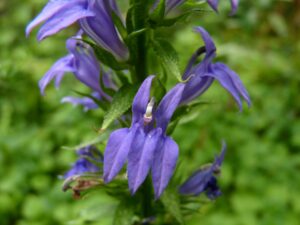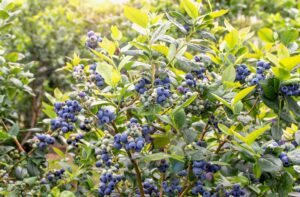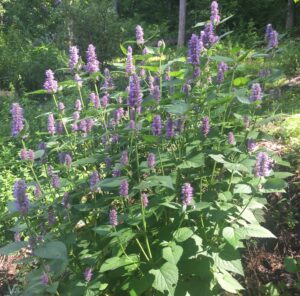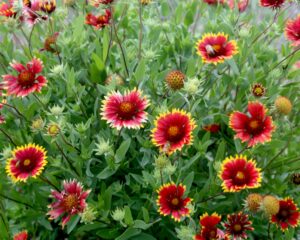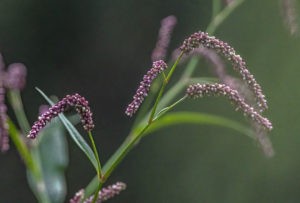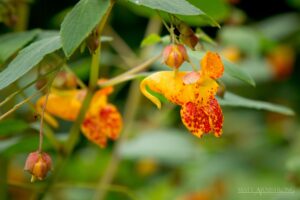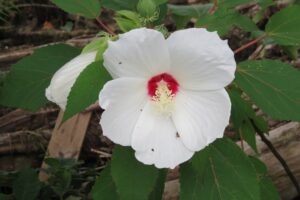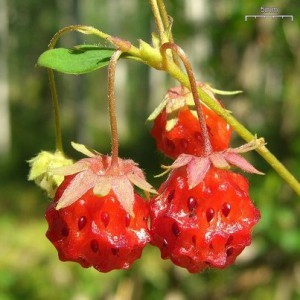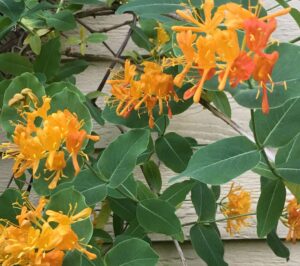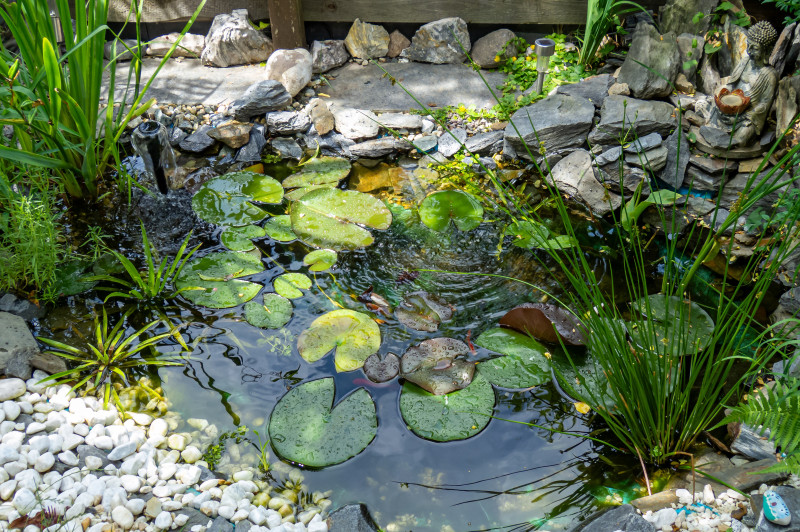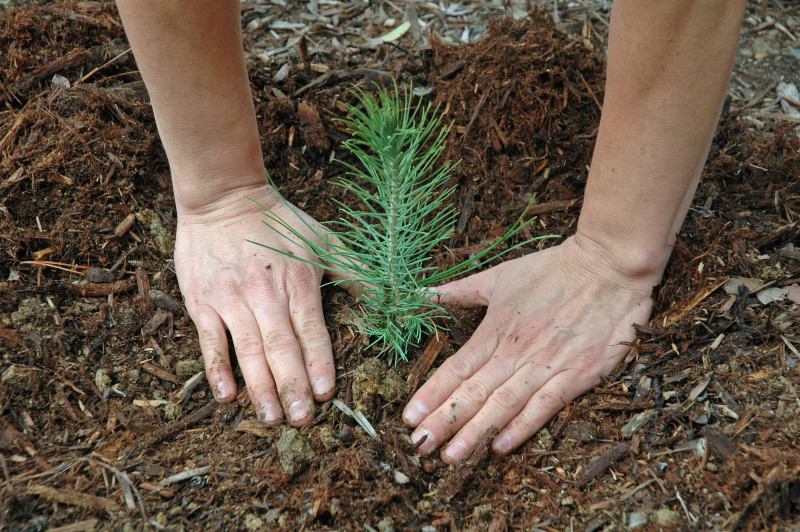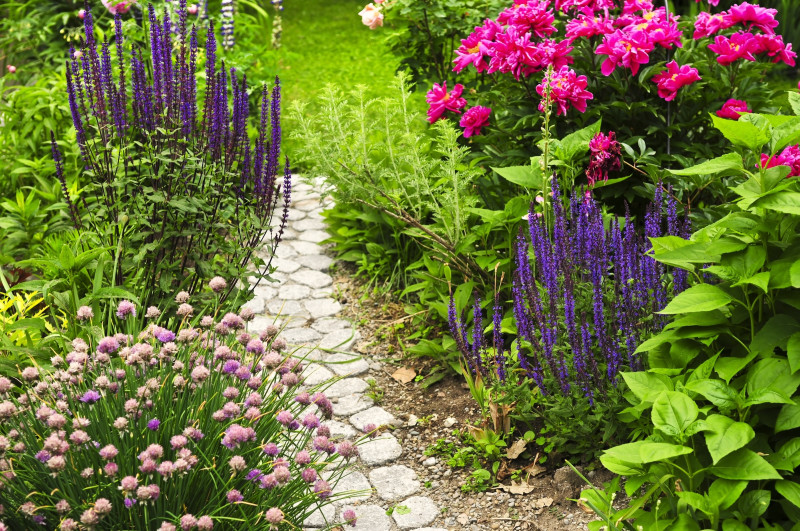In the bustling world of gardening and landscaping, certain plants often take the spotlight while others quietly thrive in the background. Yet others also offer invaluable benefits to wildlife. Sometimes, it’s nice to explore beyond the typical choices for birds and pollinating insects and look at some of the less-used native flora included here.
(Note: a sincere thank you to the many generous photographers who’ve made their great photos freely available for sites like this.)
ALLEGHENY BLACKBERRY, Rubus allegheniensis, is a bush with high wildlife value: nectar for honeybees and berries for songbirds and animals large and small. You’ll enjoy the berries, too. Native to eastern N.A., the U.S. West Coast, and some areas of the Midwest. Grows 3–6 ft. (0.9–1.8 m) tall and 6–12 ft. (0.9–3.7 m) wide. It’s thorny, so plant where that won’t be a problem. It can be grown from seed or cuttings, but seeds may be the only way to find it (available online) or take a cutting from a wild plant. Berries ripen July–Aug. Tolerates all light levels and soil types, dry to moist. Zones 2–8
AMERICAN BITTERSWEET, Celastrus scandens, is a perennial vine that blooms mid-summer. Native to central and eastern N.A. Likes shade and rich, well-drained soil. Woody, thick stems grow about 30 ft. (9 m) long and can strangle saplings, so keep away from young trees. Its fruit is poisonous to humans. So, why bother with it? Because its small, orangish fruit is loved by birds. It’s also pretty. Take care not to buy the VERY invasive and destructive Oriental Bittersweet, Celastrus orbiculatus, introduced from Asia. Zones 4–8.
AMERICAN RED COLUMBINE, Aquilegia canadensis, also called Canadian Columbine, is a perennial native to eastern N.A. Blooms from spring to early summer and is used by hummingbirds. 1–3 ft. (30–90 cm) tall, prefers well-drained, loose, slightly acidic soil. Medium water. Shade to part-shade, although some gardeners say it grows well in full sun. Easily grown, readily reseeds, and blooms the second year. Endangered in Florida. Zones 2–9.
ANNUAL PHLOX, Phlox drummondii, native to Texas and the southeastern U.S., is a good plant for those who like surprises and don’t mind a bit of disorder. They germinate early, grow to about 12 in. (30 cm) tall, bloom, and die early in summer. Seed capsules “explode” open when they ripen, flinging their seeds to the wind. Because of that, you can expect to find the following year’s seedlings coming up anywhere in your yard. This makes the plant a favorite for roadside beautification projects. Seeds can also be planted in the fall. Prefers rich, acidic, well-drained soil. Sun to part-shade. All zones.
AROMATIC ASTER, Symphyotrichum oblongifolium (formerly Aster oblongifolius), a perennial native to the Midwest and most of the eastern U.S. Grows 1–2 ft. (30-61 cm) tall, with flowers that bloom prolifically from Sept.–to Nov. Good nectar plants, they also host several butterfly caterpillars, including the Black Swallowtail, Orange Sulphur, Question Mark, Painted Lady, and Pearl Crescent. Every wildlife-friendly yard should consider this or another of the many native asters. Zones 4–7.
BEE BALM, Monarda didyma, is a perennial in the mint family. Like other mints, it’s loved by bees, butterflies, and hummingbirds. You might find it labeled as Monarda or Wild Bergamot. It’s native to the eastern U.S., south to Georgia. 2–4 feet (61-122 cm) tall and blooms July–Aug. Tolerates most soil types and needs well-drained, even moisture. Prefers full sun. It is suitable for zones 4–9.
BLACK-EYED SUSAN, Rudbeckia hirta, is an annual or short-lived perennial, depending on region. A native to eastern and central N.A. Plant in large masses to catch the attention of butterflies, bees, other nectar-loving insects. Birds will eat the seeds. Larval host for the Bordered Patch, Gorgone Checkerspot, and Silvery Checkerspot butterflies. Easily grown from seed, 2–3 ft. (61–91 cm) tall, blooms May–Oct. Drought tolerant, but occasional watering produces density and longer flowering. Full sun. Zones 3–7.
BLUE FLAG IRIS “HARLEQUIN, aka Harlequin Blue Flag, Iris versicolor, is a perennial native to northeastern U.S. wetlands and Canada. Easy to grow, it blooms from late spring to early summer and draws hummingbirds. Full sun. Prefers moist soil but will tolerate drier. 2–3 ft. (60-91 cm) tall, forming large clumps. Mildly toxic to humans and animals if eaten. A similar iris, SOUTHERN BLUE FLAG, Iris virginica, grows farther south to Florida and west to Texas. Zones 3–9.
BUTTERFLY WEED, Asclepias tuberosa, is a perennial native to all but the far northwestern areas of the U.S. and Canada. A milkweed plant, it’s also known as Canada Root, Orange Milkweed, Indian Paintbrush, and Pleurisy Root. Butterflies, hummingbirds, bees, other insects are drawn by its brilliant color and abundant nectar. Also a host for Monarch and Queen butterflies. Ladybugs visit to feast on the aphids. 1–2 ft. tall (30-61 cm). Plants are available at garden centers. Will grow from seed in dry, sandy/gravelly soil, but 2–3 years to begin flowering. Zones 4–10.
CARDINAL FLOWER, Lobelia cardinalis, a perennial, is native across the U.S. and named for the red robes worn by Roman Catholic cardinals. The flowers are precisely shaped for pollination by hummingbirds, on which it relies. Requires fertile, moist to wet soil, making it a good plant for water gardens. Will naturalize. Can take full sun in northern climates; elsewhere part-shade. 1–3 ft. (30-91 cm) tall. Blooms May-Oct. Zones 2–1.
DAISY FLEABANE, Erigeron annuus, is an annual or biennial, depending on your region. It’s distributed across most of the U.S., but particularly the east. And some scattered areas in northern and western regions. If it pops up in your yard, try to resist pulling it, even though it’s leggy—the Lynx Flower Moth eats its buds, and butterflies, bees, and beetles will visit it. Rabbits like its foliage and flowers. 1–3 ft. (3–61 cm) tall. Blooms June–Oct. Tolerates clay soil, drought. Zones 2–8.
DENSE BLAZING STAR, Liatris spicata, also called Dense Gayfeather, is a perennial that’s native to moist prairies and sedge meadows in the eastern U.S. It has naturalized farther northeast and now grows in Canada, also. 2–4 ft. (61–92 cm) tall. Its close-set purple flower heads attract hummingbirds, other birds, butterflies, and moths. Full sun, medium water. Blooms July–Sept. Zones 3–10.
If a wild FOX GRAPE plant, Vitis labrusca, invites itself into your yard, you might want to let it stay. Native to the eastern half of the U.S. and Canada and the source of many well-known cultivars, such as Catawba, Concord, and Delaware, it’ll produce grapes for both wildlife and humans. It has nectarous spring flowers for insects, and birds use its shreddy bark for their nests and even nest in it. It forms tangles and grows 30 feet (9 m) or more. Its tendrils will cling to fences and trees, but it can be trimmed annually to control it, or even be trained for an arbor. Full sun, water regularly, but don’t overwater. Zones 1–8.
Have wild GROUNDCHERRIES found their way into your yard? They’re one of many species in the genus Physalis that are also called husk tomatoes, husk cherries, poha berries, and golden berries. If you’ve been calling them weeds and yanking them out, stop! They’re edible by wildlife and humans, too. Some people intentionally grow them for their sweet-tart taste, although they’re not actually cherries. They’re in the tomato family. They ripen from August to the first frost and fall to the ground in a papery yellow husk when ready. They’re toxic until ripe, so wait until then to eat. Native to the U.S. from the east to as far west as Wyoming. A host plant for the Five-spotted Sphinx Moth. Seeds can be ordered online. Grows 1–3 ft. (30–91 cm) tall. Zones 4–8.
Whether you call them weeds or garden plants, GOLDENRODS, Solidago spp. are important fall nectar sources for pollinators, especially bees. Butterflies and moths will visit them, too. They can take over, so control by cutting off flower heads before seeds ripen. Don’t worry about their reputation for causing hay fever; they don’t. The culprit is ragweed, which blooms at the same time. (Ragweed pollen is blown by the wind, while goldenrod pollen, large and sticky, is not.) Easily grown; plant seeds in summer or fall in average soil. Needs average moisture. Blooms July–Sept. Grows 1.5 –5 ft. (0.46–1.5 m) tall. Zones 3–8.
GREAT BLUE LOBELIA, Lobelia siphilitica, is a counterpart to the Cardinal Flower and is often called Blue Cardinal Flower. Its species name, siphilitica, is based on an early belief that it cured syphilis. A native perennial, it’s perfect for woodland gardens and especially desirable because it blooms July–Oct. when many other plants have stopped. Hummingbirds use it, but it depends on bees for pollination. 1–3 ft. (30–91 cm) tall. Sun to part-shade. Requires moist soil. Zones 2–9.
HIGHBUSH BLUEBERRY, Vaccinium corymbosum, is a native alternative to the Allegheny Blackberry. Produces no thorns! It provides cover for birds and delicious berries for wildlife and humans. Needs semi-moist, acidic soil. Grows 6–12 ft. (1.8–3.7 m) tall and wide. Sun to shade. Zones 6–8.
There are numerous species of HYSSOP, Agastache spp. All but one are native to N.A. Their flowers come in white, pink, mauve, or purple, and bees, butterflies, and hummingbirds will be all over them. About 2 ft. (61 cm) tall, they prefer full sun and moist, well-drained soil, but will tolerate clay. One or more species are sure to fit your particular habitat. All are perennials, but hardiness varies with the species. Anise Hyssop is very hardy. All zones.
INDIAN BLANKET, Gaillardia pulchella, also called Firewheel, in your butterfly garden? Native to the US, it’ll be visited by butterflies, including the American Painted Lady, and it’s especially important to bees. Depending on where you live it’s a short-lived perennial or an annual. Easy to grow, its showy flowers have a wonderfully long blooming period. Heat and drought tolerant. Deadheading increases bloom time, but if you want plants the next year, allow flowers to reseed. 1–2 ft. tall, full sun to part-shade, all soil types, but prefers it well-drained. Zones 3–10.
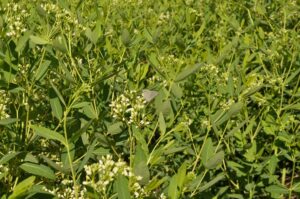
Hemp Dogbane, Apocynum cannabium, and Gray Hairstreak Butterfly, Strymon melinus (Tony Frates / Flickr; CC BY-NC-SA 2.0)
HEMP DOGBANE, Apocynum cannabium, is loved by butterflies, skippers, moths, and bees. The plant’s name suggests a link to cannabis, but that’s the only similarity, and it’s toxic. A native perennial, it grows throughout N.A. and southern Canada. Native Americans used its roots for herbal medicines and the fibrous roots for strong string and rope. A good plant for naturalized butterfly gardens. It spreads, so plant it where it won’t crowd out other species. 2–4 ft. (61–122 cm) tall. Full sun. Dry to medium, sandy soil. Zones 4–8.
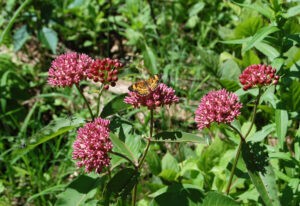
Purple Milkweed, Asclepias purpurascens, and Silvery Checkerspot Butterfly, Chlosyne nycteis (Peter Gorman / Flickr; CC BY-NC-SA 2.0)
There are two plants called PURPLE MILKWEED. One is Asclepias cordifolia, also known as Heart Leaf Milkweed, native to California, Nevada, and Oregon), and the other is Asclepias purpurascens, native to the eastern half of the U.S. and Ontario, Canada. These milkweeds are much less common than Butterfly Weed, described earlier, but equally appealing as a nectar plant and host to the Monarch and many other insects. Non-invasive. Endangered in some areas—don’t remove from the wild—seeds are available online; follow instructions carefully. Water regularly, but don’t overwater. Grows to 3 ft. (91 cm) tall. Zones 5–9.
Do you let these plants grow in your yard or pull them as “weeds” when they appear? You might want to let them be, as SMARTWEEDS (or KNOTWEEDS) are 130 species of native plants in the genus Polygonum that produce seeds eaten by twenty species of ducks and geese, Bobwhites, Mourning Doves, Ring-necked Pheasants, four species of rails, and thirty nongame birds. And bees love the flowers. Look for lance-shaped leaves and flowers on spikes, and depending on the species, they may be pink to red-purple, red, or white. Some species have upright spikes, while others are drooping. Safe for humans to eat when cooked, but don’t chew it raw: called “nature’s pepper,” some are relatively mild, but others will really “smart” in your mouth with a hot, peppery taste. Full sun to light shade; moist, nutrient-rich soil. Found in all zones across the U.S. and southern Canada.
People who grow SPOTTED JEWELWEED, Impatiens capensis, love it. It’s a native annual visited by hummingbirds, butterflies, bees, and other nectar-loving critters. Maybe you’ve heard of it as TOUCH-ME-NOT because when a seed pod is touched, the seeds explode out of it. Because of this, however, it can take over and crowd out other native plants. Some states consider it a noxious weed, so don’t plant if unsuitable for your area. It self-seeds, so deadhead if you don’t want it proliferating. Forms a dense stand up to 4+ ft. (122 cm) high. Part-sun to full shade. Most soil types, moist to wet. Plants may be available locally or online in the spring. Seeds need four or more weeks of cold weather for germination, so sow them in the fall. Native to the eastern two-thirds of the U.S. and most of Canada. Zones 4–10.
SWAMP ROSE MALLOW, Hibiscus Moscheutos, is loved by hummingbirds and insects for its nectarous flowers. Ducks eat the seeds, and other wildlife use it for cover. It can adjust to drought but prefers lots of water. A native perennial of the Southeast, it thrives in moist or swampy soil in large colonies alongside freshwater rivers and streams. Stems grow about 8 ft. (2.4 m) tall. Full to partial sun. Zones 5–10.
VIRGINIA STRAWBERRY, Fragaria virginiana, plants deliver fine, sweet berries that birds love — and people, too. You might not want to share it with wildlife! All the cultivated strawberries of today are hybrids from this native species and a SA species. The seeds don’t germinate well, so space plantlets a few inches apart in sun to part-shade. Tolerates dry soil. All zones.
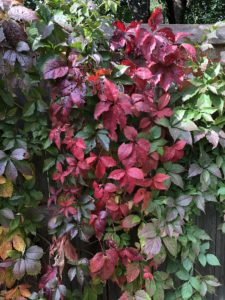
Virginia Creeper, Parthenocissus quinquefolia, in the fall as it changes from green to red foliage (Ross Dunn/Flickr; CC BY-SA 2.0)
VIRGINIA CREEPER, Parthenocissus quinquefolia, is a native vine. Like ivy, its tendrils will find a hold on just about anything—and it grows and grows. It’s a beautiful vine for fences and walls. In summer, it’s a host plant for Pandorus and Achemon Sphinx Moths and benefits other wildlife by providing cover within its thick foliage. In the fall, it turns brilliant red, and its purplish-black berries are a feast for birds. Found in eastern and central North America, from southern Canada to eastern Mexico and Guatemala. Any soil, drought tolerant, sun to part shade. Zones 3–9.
YELLOW HONEYSUCKLE, Lonicera flava, is native to eastern areas of the U.S. but will grow almost anywhere. Showy, bright yellow flowers in spring to mid-summer are visited by hummingbirds and butterflies. Clusters of red fruits in late summer aren’t edible by humans, but birds love them. It’s non-invasive and should not be confused with weedy, invasive Japanese Honeysuckle. Best in sun, tolerates part shade. Most soil types, medium water. May be hard to find locally, but available online. Zones 4-9.
In your yard: 27 birds to look for
Plant these trees loved by wildlife
Best native grasses for a yard
Guidelines for collecting seeds

